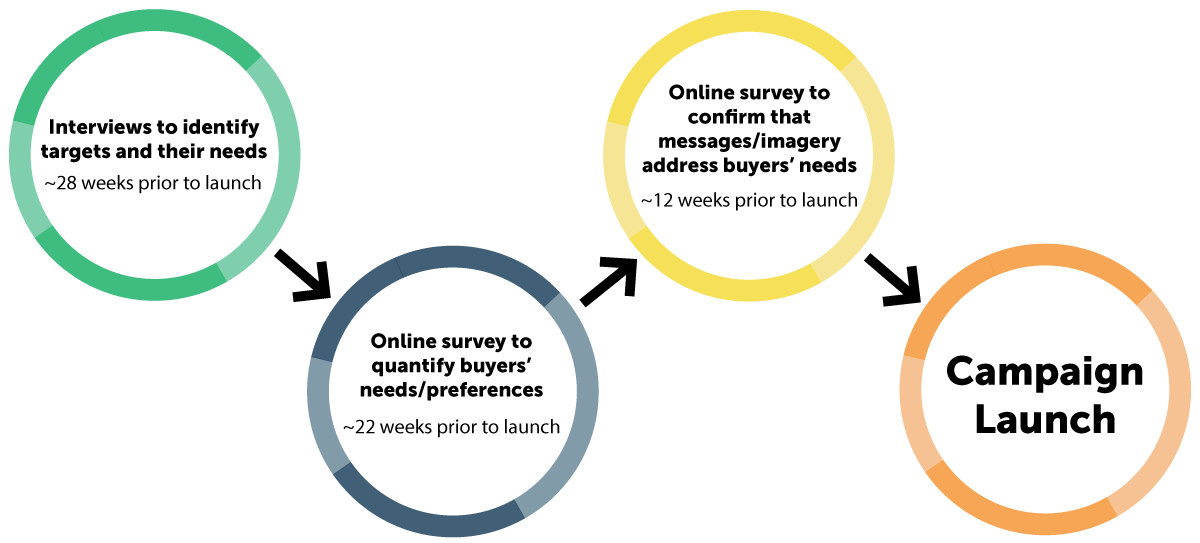Considerations for biopharma industry marketers
Marketing campaigns are important customer-facing tools in the biopharma industry, aimed at a variety of objectives from introducing a company or informing potential customers of a company’s capabilities to educating people on a particular topic. Designing a campaign, however, can sometimes feel like ‘guesswork’. How do you know if you’re targeting the right individuals, addressing impactful topics, or using appealing messages or imagery? Marketers often come to ISR to conduct market research around their proposed ideas and marketing materials prior to campaign launch.
How our clients approach incorporating market research into their campaign planning and execution runs the gamut. We have clients who very meticulously plan their campaign-related market research early and regularly while others come to us only when they feel unsure about a particular campaign or message. Of course, there are also marketers who do not perform market research on their campaigns for a variety of reasons such as budget constraints, timeline constraints, or a lack of knowledge regarding the benefits of market research or how the process works. We put together this article as a resource for marketers to provide some potential approaches and considerations for why and when to utilize market research in your campaign planning.
In the biopharma services space, many marketing campaigns are centered around specific corporate objectives. “We want to grow our presence in the cell and gene space” or “Our goal is to inform potential customers about our HEOR capabilities.” Marketing objectives for the near-term are often to support those corporate goals so campaigns and messaging are designed around each objective. This is where market research begins to fit in.
Who is your audience and what do they care about?
Before putting campaigns out into the marketplace, it’s important to know who you want to reach. For example, if you’re seeking to message about HEOR capabilities, you’ll want to know which roles at biopharma companies are responsible for outsourcing HEOR work and assessing vendors. You’ll also want to know what it is they care about, the important purchasing drivers when outsourcing HEOR work. For example, if decision-makers are interested in scientific expertise but your campaign is instead touting fast timelines or low cost, you might be missing the mark.
Market research at this stage can help marketers understand the relevant targets for the campaign as well as some key topics to address. These key topics can then permeate not only your marketing campaigns but also deeper educational materials such as webinars or thought leadership pieces.
Another useful learning is where potential targets look for industry news or educational materials about a topic. Knowing the types of channels and styles of content they utilize helps marketers decide where to place their campaign messages. Analytics for online placements can then be used to determine how targets are interacting with the ads.
Research around these objectives can be qualitative or quantitative in nature. If this is a relatively new space for the service provider and they don’t yet have a good handle on the dynamics, we typically suggest starting with qualitative interviews to better understand who the decision-makers are and explore purchasing drivers at a deeper level. If the marketer or other stakeholders at the service provider have a strong grasp on the space in which they are creating the campaign, then we suggest conducting a quantitative study via an online survey with a larger audience to gather more confirmatory results. Research to understand the appropriate targets and what they care about can be conducted at any point after the marketing objectives are decided. That said, sooner is better than later.
Do your messages and imagery resonate?
Once marketers have determined their audience and the topics they want to address in the market, they can begin to craft messages and design creative materials. This presents another juncture at which ISR’s customers come to us for market research.
Some key information to learn about marketing messages includes whether they are important to the target audience, whether they are relevant to targets’ day-to-day responsibilities, and whether the messages are believable and motivating. We can also ascertain whether the wording used in the messages is clear and easy to understand. Creative pieces may be assessed for how potential targets react to the images, whether they are appropriate for the messages they contain, and whether the images are a good fit for the type of service provider that is using them.
This type of research may not be necessary for all types of campaigns. If the campaign is designed to mostly be placed in banner ads, for example, perhaps only a handful of words will be used and assessing believability and clarity isn’t useful. On the other hand, the longer the messages are and the more investment they take to develop, the more useful testing becomes. Testing longer, more detailed messages is good practice to ensure they are easily understood and will resonate in the marketplace.
Because we are looking for confirmatory data at this stage, we would employ an online survey to reach a larger audience. Potential respondents would be screened for the appropriate background and then asked a series of questions to gauge their reactions to the messages and creative pieces. We suggest starting to design this market research at least 12 weeks prior to campaign launch to leave sufficient time to implement any refinements to the messages or imagery that result from the market research findings.
Planning your market research
The types of research and timeframes described thus far and depicted in the graphic below are what we consider to be “ideal” for thoroughly testing your promotional campaign materials. Because these research projects build on each other and cannot be run concurrently, to perform all of the “ideal” steps would mean the research around your campaign would start about 7 months prior to campaign launch.

However, we also acknowledge that not every campaign necessitates or can afford this degree of research. Some campaigns are the lynchpins of a company’s public-facing persona and are intended to be active for quite some time while others are shorter-lived, lower-stakes endeavors. As mentioned above, some customers don’t have the budget to run multiple research projects around campaigns and others may not have enough time to complete the suggested projects prior to their planned launch timeframe. We describe below a few places where and why our customers make tradeoffs regarding their market research approach.
Customize projects for your market research needs
When reviewing the stages of market research described in this article, think through the goals of your campaign and where you might have the biggest gap in knowledge. If you have a firm grasp of who your target audience is, then perhaps you don’t need research to dig deeper. However, if you feel you aren’t confident your messages will be impactful with your customers, maybe message testing is where you focus your research efforts.
Another way to approach these decisions is to consider where you think your biggest risks are in the campaign. Is it that you don’t know if you’re targeting the right audience? That your messages don’t hit home or your creative pieces aren’t appealing? Did you try something edgy with the campaign and you’re worried about the response? The areas with the biggest risks are good places to start when deciding where to spend your market research dollars. If you need just one portion of the market research described in this article, we recommend allocating about 10 weeks for the project and allowing yourself enough time to implement any learnings after the project is complete.
Not all marketing campaigns are created equal, nor are their needs for market research. However, regardless of the campaign or the situation, taking the time to consider how market research could improve your campaign is a worthwhile endeavor. If you reference these research outcomes and check the boxes along the way, you’ll greatly increase your chances of achieving the business outcomes that prompted you to create the campaign in the first place.
Market Research Outcomes
- Ensure you’re targeting the right people
- Dig deep into understanding your buyers’ needs and preferences
- Confirm that your messaging and imagery speak to those needs
- Verify that your messaging and imagery are consistent with your brand, image, and industry (allowing for the fact that you may be intentionally stretching your targets’ attitudes and beliefs)


